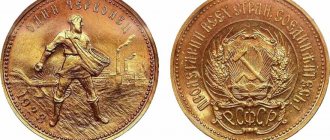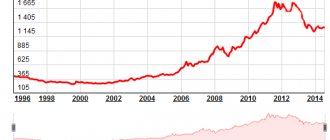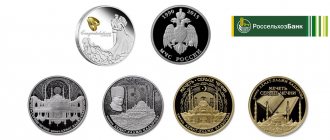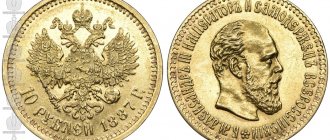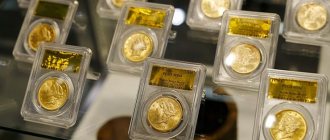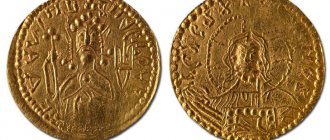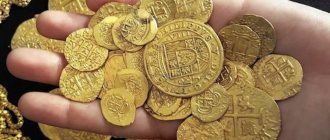The history of coinage and monetary circulation is studied by an auxiliary historical discipline - numismatics. Numismatic collecting - the systematic collection of coins - should be distinguished from numismatics as a science. Of great interest to numismatists are, among others, Russian gold coins, minted over the centuries, starting from the Old Russian state. Among them are the “zolotnik” (zlatnik) of Prince Vladimir, the “shipman” of Prince Ivan III, “Ugric” coins, the golden “wedding book” of False Dmitry I, “Novgorodka” of Vasily Shuisky. Later, the Romanovs (from Mikhail to Peter) minted chervonets, half-chervonets and quarter-chervonetsy.
The history of gold coins in France
The specifics of the development of France as a state had a great influence on the appearance and spread of banknotes made of gold.
The first coins were originally made from pure gold. However, over time it became known that gold without impurities was quickly very soft and abraded.
For this reason, small quantities of silver or copper were added to the material for making banknotes, which significantly increased the hardness and strength of the coins.
Development of coinage
Starting from the 9th century, imported money was used in Rus'. For a short period in the 10th-11th centuries, gold and silver coins were minted. There were also silver bars called hryvnias.
In the XII-XIV centuries, Rus' did not have its own coin; this was the period of the Tatar-Mongol yoke, when a significant share of the precious metal went as tribute. From the end of the 14th century, Rus' carefully began producing its own coins - small and lightweight “scales” (they can be considered a prototype of future kopecks). The scales did not have a constant standard weight. Russian princes, and later tsars, constantly reduced their mass in order to save on consumable material. Often, to determine the true value, scales were paid by weight.
Tsar Ivan III issues his own gold coins, but these are not means of payment, but award signs (medals). Their appearance is similar to money: on one side there is a portrait of the sovereign, on the other - a double-headed eagle.
The centralized minting of banknotes began in the 16th century by John IV (the Terrible). He brought the scales to a single pattern, but they noticeably decreased in weight.
Over time, attempts are being made at monetary reforms, the goals of which are to enlarge coins, as well as introduce the use of copper and gold for their minting. Gold money and kopecks (“Novgorodki” and “Moscow coins”) of Vasily Shuisky appeared - 1610, silver rubles and copper kopecks, altyns, pennies of Tsar Alexei Mikhailovich - 1654, silver “Efimki with a sign” (countered on Western European thalers) - 1655
Antique gold coin - franc
In France, until the middle of the 14th century, coins were minted from bronze and silver. The beginning of making money from gold coincides with the period of the Hundred Years' War.
In 1360, the first antique French gold coin, called the franc, was produced. The coin weighed about 3.89 grams and was minted from pure gold.
The front of the franc featured an image of an armored king riding a horse. This coin was popularly called the “horse franc”.
The coin, which was produced under King Charles V, depicted the royal personage in full size. In common parlance it was called the “foot franc.”
You may be interested in: Gold coins of Nicholas 2 - making money on collectible coins from the reign of Nicholas 2, tips for beginners
The gold franc was minted until the middle of the 15th century, and during the reign of Louis XI this French coin was replaced by the gold ecus.
Circulation
The exact number of gold rubles and chervonets of Tsarist Russia from 1701 to 1711 is not known. Coins were minted depending on the needs of the country. They were produced in small quantities for palace circulation, regular use and international trade. It is known that the first circulation of rubles was 118 copies. Total circulation of chervonets for 1713-1714. amounted to 8,766 pieces.
Catherine's rubles have become widespread both in Russia and outside the country. Coins were minted in large quantities - from 26,000 to 92,000 copies. During this period, anniversary and commemorative rubles were issued in limited quantities. The Sestroretsk ruble is known, whose weight was 1 kg of gold, diameter - 76 mm, height - 35 mm.
Under Emperor Nicholas II, the circulation of gold coins and their variety increased significantly. During this period, not only gold, but also silver coins of Tsarist Russia were in circulation.
A record number of 5 rubles were minted in 1899 - 27 million pieces. In subsequent years, the circulation decreased, and in 1901 it amounted to only 50,000 coins. Imperials and semi-imperials were produced in smaller quantities - from 56 to 118 pieces annually.
The appearance of gold ecus in France
In medieval France, coins were minted from gold, which were called “ecu”. This money was marked with an image of a heraldic shield.
The first pure gold ecus were minted during the reign of King Louis IX of France. This ancient French gold coin was originally called the denier, but this name quickly changed to the ecu.
The coin under Louis weighed approximately 4 grams and reached 24 mm in diameter.
The French king Philip the sixth modified the gold ecus - the coin became larger in diameter and heavier.
There are several options and names for gold ecus:
- ecu, which depicts the throne;
- ecus with a crown on the obverse of the coin;
- ecu with the image above the royal crown of the sun.
The weight and diameter of the coins also changed constantly. In the middle of the 14th century, the coin weighed about 4 grams, and by the end of the century - about 6 grams.
Varieties of metal money of Nicholas II
During the reign of the last Russian Tsar Nicholas II Alexandrovich, more than two dozen types of coins were issued, half of which were made of gold. Silver and copper money and even 5 rubles were also minted from aluminum (trial version). In gold version, 5, 7.5, 10, 15, 25 rubles are known.
From 1895 to 1897 the mint minted semi-imperials and imperials (imperial or imperial Russian gold coins). During this period, the semi-imperial corresponded to five gold rubles, the imperial - ten. The first were produced in 36 pieces annually, the second in a slightly larger circulation: 125 copies per year. This suggests that these imperial banknotes were not intended for mass circulation.
Meanwhile, a monetary reform was carried out in the state, prepared by the Minister of Finance Sergei Yulievich Witte. It assumed a transition to gold monometallism (when the monetary system is based on one metal, in this case gold). This is a system in which there is free circulation, issue and exchange of gold coins for other types of banknotes. At the same time, the ruble was devalued, and the price of the imperial rose from 10 to 15 rubles (since 1897).
In order to distract the population from reducing the price of the ruble by a third, Nicholas II wanted to replace the monetary unit with a new one - Russian. In accordance with the imperial decree, a trial batch of gold coins was produced in denominations of 5, 10 and 15 russ (respectively: a third, a half and a full imperial). The matter did not reach mass production, the sovereign did not like the new money (inconstancy is considered one of the character traits of Nicholas II), and Witte’s financial reform was carried out without changing the name of the currency.
New imperials and semi-imperials are minted with denominations in rubles - 15 and 7.5, respectively. Otherwise, their design is completely identical to its predecessors. This happened only in 1897, but 15- and 7.5-ruble coins are not rare, because they were issued in large editions: the first - 12 million pieces, the second - 16 million.
From 1898 to 1911 In the Russian Empire, gold five-ruble notes and chervonets (10 rubles) are produced in large quantities. The five-ruble coin is now no longer a half-imperial coin, but only a third of the main imperial monetary unit. They are similar in design, but the weight is reduced: 4.3 g (against the previous 6.45 g), the pure gold in it is 3.47 g (in the semi-imperial it was 5.8 g), the diameter is also reduced from 21.3 mm to 18.5 mm due to narrowing of the edge.
Golden Nikolaev chervonets also lost in weight, mass of pure gold and size compared to the imperial:
| Title and date | Diameter, mm | Weight, g | Weight of pure gold, g |
| Imperial 1895–1897 | 24 | 12,9 | 11,61 |
| 10 rubles 1898–1911 | 22 | 8,6 | 7,74 |
Since 5- and 10-ruble coins were issued in huge circulations at that time - several million copies per year - they are very common now, but there are exceptions: rare royal gold chervonets of 1906, for which several tens and even hundreds of thousands of dollars. That year, only 10 coins of 5 and 10 rubles were minted.
Twice during his reign, Nicholas II issued commemorative (gift) coins of 2.5 imperials (25 rubles): in 1896 - in honor of his coronation and in 1908, timed to coincide with his 40th anniversary. In both cases, by analogy with the imperial, a double-headed eagle is depicted on the obverse, and a portrait of the autocrat is depicted on the reverse. All parameters were increased: diameter: 33.5 mm, weight - 32.26 g, pure gold - 29.03 g. The second issue caused financial confusion, because during this period one imperial was no longer equal to 10, but 15 rubles, but there was a lot of damage did not harm the market: the circulation of commemorative coins in each issue was only 175 pieces.
In 1902, another 235 Nicholas gold coins of 100 francs or 37.5 rubles were issued, repeating the design and weight (with a larger denomination) of the 1896 gift 25-ruble coin.
Gold louis d'or - coin under King Louis XIII
In the 17th century, money began to be issued from high-quality gold, called louis d'or.
This ancient French gold coin was first produced during the reign of King Louis 13.
During the reign of the monarch, the louis d'or was the main currency of France. There were a large number of louis d'or, which differed from each other in weight and diameter. There were coins weighing from 4 to 6 grams.
The record gold coin was a louis d'or weighing almost 10 grams.
The obverse of the gold coin usually featured the profile of the king.
Louisdor was made until the Great French Revolution and the subsequent transition to the main monetary unit - the franc.
Gold notes with the louis d'or foot continued to be issued in France until 1803. The next payment unit was the gold Napoleon.
You may be interested in: Gold coins of Tsarist Russia: history, description, cost
Historical and market value of individual specimens
Even at the turn of the 10th-11th centuries, Prince Vladimir minted “zolotnik” (or “zlatnik”). Only 11 copies of this first ancient Russian gold coin have been found. The only copy of the “shipman” - the medal of Ivan III Vasilyevich, minted between 1471 and 1490 - is kept in the Hermitage. The golden chervonets of Peter I remains desirable for many collectors. These rare specimens at auctions reach prices of up to several hundred thousand dollars, depending on their condition and year of issue.
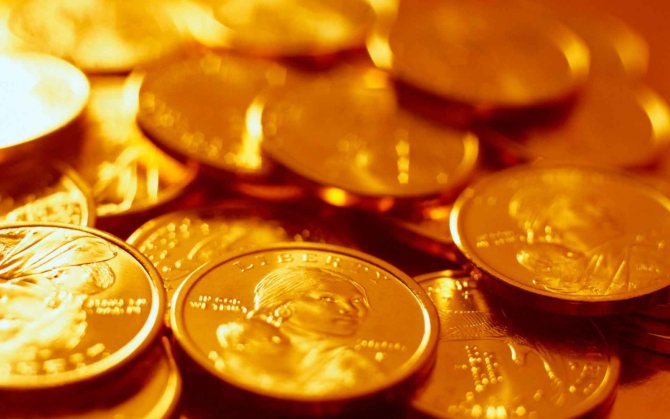
Almost each of the subsequent sovereigns of the Russian Empire printed rubles, chervonets or imperials from gold. From 1828 to 1845, during the reign of Nicholas I, “white chervonets” were issued, now classified as numismatic rarities. During a period of acute shortage of precious metals, the idea arose of producing coins from platinum, which was mined in large quantities in the Urals. The denomination indicated on them is interesting: “3 rubles for silver.” Soon “6...” and “12 rubles for silver” appeared. On the obverse is the coat of arms of Russia: an eagle with two heads. They were 97% pure platinum. One of the first test copies of the “white chervonets” has been preserved; it is exhibited in the Hermitage (St. Petersburg).
The preserved Rus of Nicholas II are highly valued (about 500 thousand dollars at auctions). There are only five sets of them. The owners of three of them are museums in Russia (the State Historical Museum and the Hermitage) and the USA (the Smithsonian Museum). Another set is in a private collection. The fate of the fifth is unknown. According to one version, it was divided into separate coins and sold to different collectors.
At all times, and especially now, coins of the Russian Empire arouse interest and are in considerable demand among both domestic and foreign numismatists. Not too many examples of imperial coinage art have survived to this day. After all, the money of those times was printed from pure metals with a small amount of impurities, so over the years they were often melted down or used to make jewelry. With particular interest, collectors “chase” gold rarities that were produced purely for palace use. In modern times, they can be found in single copies, which makes them very expensive at auctions.
But it’s not only the high market value of ancient coins from Tsarist Russia that inspires admiration. Imperial coin production, starting from the reign of Peter I and until the tragic end of the reign of Nicholas II, gave the world magnificent examples of monetary circulation - real works of art created by masters of their craft.
Gold coins in France since the 18th century
The appearance of a popular coin in numismatics, the Napoleondor, is associated with the rise to power of Napoleon I. These were gold coins in denominations of 20 and 40 francs.
There are several types of gold Napoleons:
- Emperor Napoleon;
- First Consul Napoleon;
- coins “with a wreath”;
- coins “without a wreath”;
- with a digital designation of the year of manufacture;
- with a letter designation of the year of minting.
Napoleons continued to be made after the overthrow of the emperor and the restoration of the monarchy. The profiles of kings were depicted on gold coins. The reverse of the coin usually featured the royal coat of arms.
The last monarch of France under whom Napoleons were made was King Louis Philippe I.
During the Second Republic, a gold coin with a face value of 20 francs, called the “Angel,” was very popular.
The first edition of this coin was issued at the end of the 18th century as a replacement for the old Louis Dor. The obverse of the coin features an angel writing down the French Constitution.
Also, almost at this time, a 20-franc gold coin was minted, which depicted the goddess of fertility, harvest and agriculture, Ceres. This French antique gold coin was produced in only three editions.
Gold coins minted during the reign of Napoleon III are considered classic investment coins.
During the Third Republic, a gold coin with the image of Marianne, a symbol of freedom in France, began to be issued.
Monetary reform of Peter the Great
In pre-Petrine times, the ruble was not a means of payment, but only a unit of account. During the reign of Tsar Peter Alekseevich Romanov, their own rubles and chervonets appeared in circulation. The word “ruble” comes from the verb “to chop” (they chopped part of the silver hryvnia). The stump of the hryvnia - the ruble - has been used as a monetary unit since the 13th century.
Peter the Great managed to successfully carry out financial reform, the result of which is noted:
- introduction of industrial (machine) coin production;
- consolidation of banknotes;
- the emergence of the ruble as a monetary rather than a unit of account;
- clear equation of 100 kopecks to 1 ruble;
- minting of gold chervonets.
The first regular gold coins of the Russian Empire - chervonets - were issued in 1701 in the amount of 118 pieces. There is only one known copy of Peter the Great's chervonets in gold (issued in 1706), on which the date is indicated in letters. It is kept in the Vienna City Museum. However, according to other versions, similar specimens exist in varying states and are kept by private Russian collectors.
Traditionally in Russia, large gold coins of foreign and domestic production were called chervonets due to the reddish tint of the metal inherent in the material of high standard (“chervonnoe gold”).
Peter I adopted a lot from the enlightened Dutch and, applying new knowledge in practice, introduced coins very similar to Dutch ducats. But the very first chervonets, issued by the great reformer in 1701, were copied from the Hungarian ducat (Ugric, Ugric gold) in full compliance in weight (3.47 g) and gold purity (986).
The denomination on these coins was not indicated, but the gold chervonets circulated in Peter’s times as 2 rubles 30 kopecks. They were minted from 1701 to 1716. It was not very convenient to use them, because two rubles at that time was a significant amount, so they were not popular among the people. In addition, a “double chervonets” was minted, its mass was 6.94 g.
Since 1718, chervonets were replaced by 2 gold rubles. The denomination is almost the same, but the purity is lower. They already have a clear inscription of the denomination.
"Transition" period
The era of the Roman Empire was a transition period for gold currency. The state minted Aurus coins weighing 7.5 grams and used them for administrative payments and settlements with legionnaires. The value of the metal still prohibited its use for everyday operations. However, everything changed in 300 BC. This period remained in history thanks to a significant reduction in gold supplies from Spain and Eastern Europe. And the heavy "Aurus" was replaced by "Solid".
This time in history is also associated with the emergence of the first coin houses and a sharp increase in the scale of minting. The vast territory of the Roman Empire produced coins on a scale comparable to modern ones. The decline and collapse of the state also affected the coin, the production of which was discontinued for almost a thousand years. Mention of “Solid” reappeared only with the advent of the Byzantine Empire.
This is interesting! The successor of the “Solid” - “Bizantin”, which was in circulation in Byzantium, is the prototype of the first Russian gold coins.
Time for triumph
The most striking moment in the history of gold coins can be called the 19th century. This time is characterized by the depreciation of silver and the incredible demand for the royal chervonets of Russia. The reason for the excitement in Europe, in this case, are:
- metal quality (the coin is minted from 900-karat gold);
- the ratio of the precious metal in the product, where a 9 gram chervonets contains 7.8 grams of pure gold;
- stability of the ruble, in which the Russian currency is confirmed by the country's gold fund until the revolution.
After the change of power, the ruble was withdrawn from circulation, but the significance of the mint remained unchanged. The gold coin has changed its appearance, but has not ceased to be relevant. Banknotes were used as a means of circulation until the mid-20th century. In the period after World War II, gold coins changed their purpose, becoming an investment vehicle.
